Bayes and causal inference#
#Bayes #Causal-Inference
See also [[04_Bayesianism]]
Rev Thomas Bayes 1702-1761.
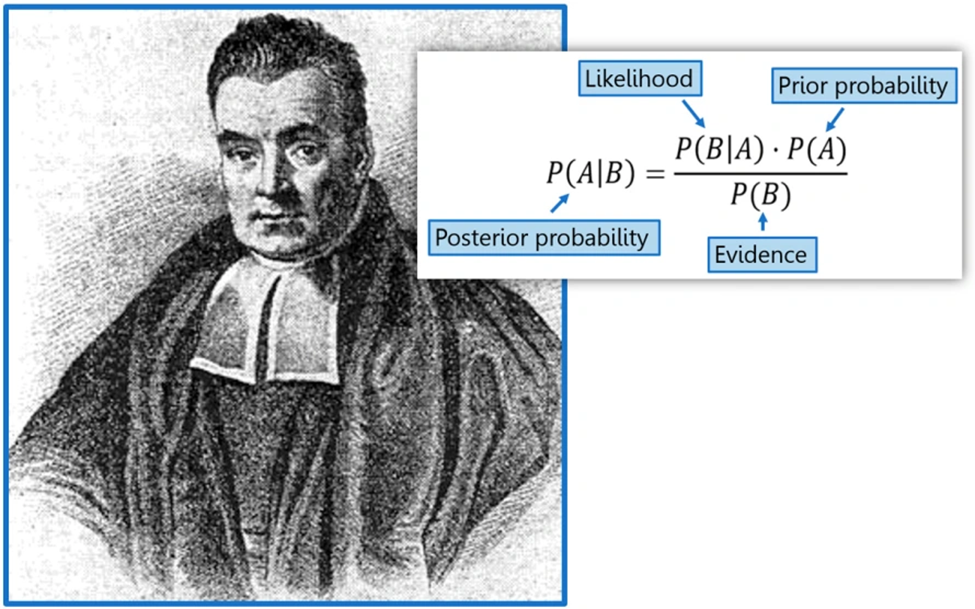
Bayes genius was to calculate the probably of a cause (the hypothesis) from the occurrence of an effect (the evidence). In Bayes’ day this was known as inverse probability.
Induction and deduction#
Induction: Evidence to hypothesis; generalising from observation. Example of an inductive argument: “All ravens I have seen are black. Therefore ravens are black.”
Deduction: Hypothesis to conclusion; applying what is known. Example of a deductive argument: “All noble gasses are stable. Neon is a noble gas. Therefore neon is stable.” Multiple hypotheses may be generated (by induction), and their conclusions checked against the facts; “When you have eliminated the impossible, whatever remains, however improbable, must be the truth” (Sherlock Holmes).
Bayes theorem classification#
From StatQuest…
Bayes theorem#
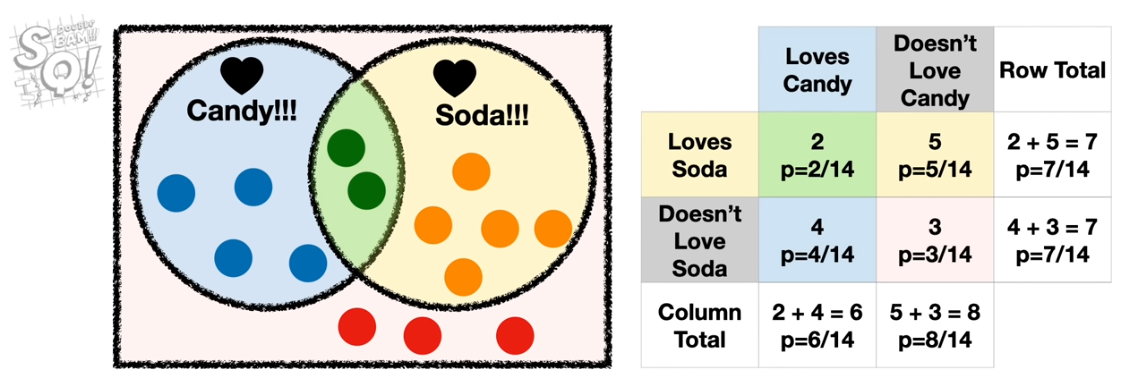
We can use conditional probabilities to answer questions like “What is the probability of someone not loving candy if they love soda?”
p(not love C & love S | love S) = p(not love C & love S) / p(love S) = 0.71
Note: Stating not love C & love S when we have conditioned upon love S can be seen as redundant, and can be shorted to p(not love C | love S), but writing out in full can help get the calculation right!
With Bayes theorem we do not need to know all probabilities:
\(P(A|B) = \frac{P(B|A)\times P(A)}{P(B)}\)
Or using Evidence and Hypothesis (what is the probability our hypothesis is true given the evidence):
\(P(H|E) = \frac{P(E|H)\times P(H)}{P(E)}\)
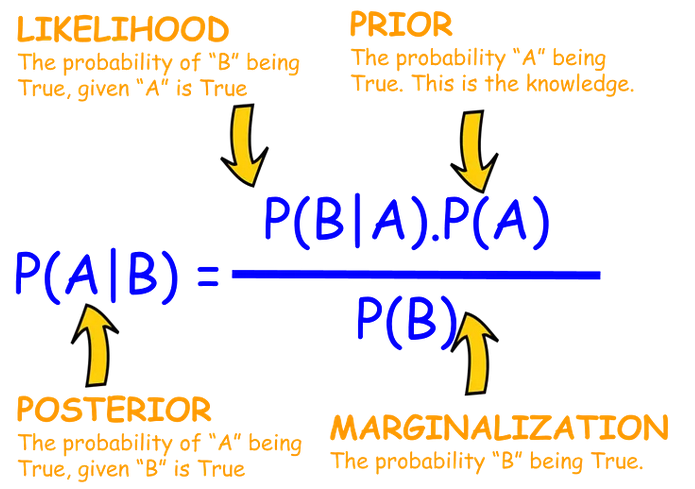
The marginalization is the combined probability of B if the hypothesis (A) is true, or not true:
P(B) = P(A)P(B|A) + P(¬A)(B|¬A)
Likelihood / marginalisation is also known as the likelihood ratio - that is how much more likely is B given that A is true.
We need to know one conditional; probability, P(B|A), but we construct the calculation so we use the conditional probability we can more readily estimate (what would the world look like if the hypothesis were true) in order to calculate the conditional probably that is harder to measure. We also need to observe the frequency of our evidence, B, and we need to start with a prior estimate of our hypothesis, A.
Bayes may also be applied to ‘strength of belief’ in a hypothesis, where new evidence, which gives us P(B) (or at least an estimate of it) is used to update confidence in hypothesis, A.
Probability and likelihood#
Probability: Given a fixed distribution, what is the probability of a given observation. Probabilities are areas under a fixed distribution: \(pr(data|distribution)\).
Likelihood: Given a fixed observation, what is the likelihood of seeing that observation with the given distribution? \(L(distribution|data)\).
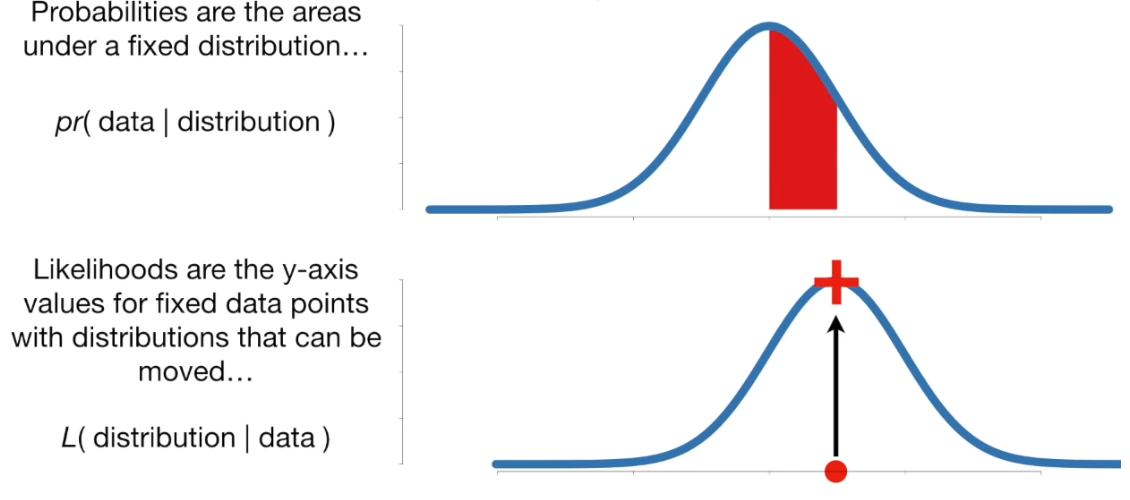
A worked example (diagnostic test)#
“Suppose you take a medical test and it comes back positive. How likely is it that you have the disease?”
Our evidence (E) is a positive test. Our hypothesis (H) is that we have the disease.
P(test|disease) is the sensitivity of the test, and is the likeihood or forward probability in Bayes. It is the same as P(E|H).
What we care about is the inverse probability to sensitivity - what is the probability of having the disease if the test is positive: P(disease|test) or P(H|E).
Let’s consider a 40-year old woman:
The probability of getting breast cancer in a year is about 1 in 700. That is our prior probability.
The sensitivity of mammograms for a 40-year woman is 73 percent.
The false positive rate (1 - sensitivity) for a 40-year woman is about 12 percent.
A positive test can come from those with cancer (true positive) or those without (false positive). P(T) is therefore a weighted average of P(T|D) (sensitivity) and P(T|~D) (1 - specificity).
P(T) = (1/700 * 0.73) + (699/700 * 0.12) = 0.121
\(P(D|T) = \frac{P(T|D)\times P(D)}{P(T)} = \frac{0.73\times 1/700}{0.121} = 0.0086\) (1 in 116).
Another worked example of a diagnostic test#
A disease has a incidence rate in the general population of 0.1%.
A test has been developed:
100% sensitivity: P(positive|disease) = 1.0
5% false positive: P(positive|no disease) = 0.05
Suppose a randomly selected person has the test and it is positive, what is the probability that they actually have the disease?
We want to compute P(disease|positive)
Let’s imagine 1000 people
1 person will have the disease, 999 do not
The 1 disease person will test positive
Of 999 non-positive ~50 will test positive
So 1 real disease out of 51 non-disease positive
= 1/51= 0.0196 = ~2%
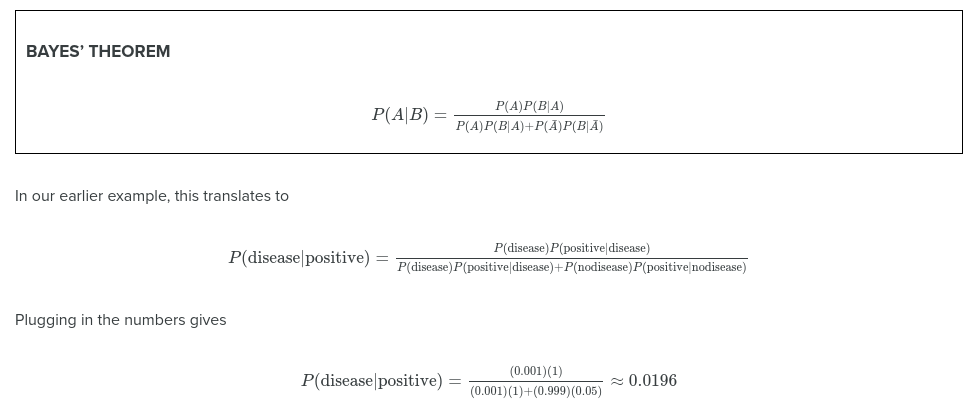
Another worked example#
We are told a person is shy and likes to keep things tidy. Are they most likely a librarian?
Let us assume there are 20X more farmers than librarians (our population is a librarian + 21 farmer)
Our Prior, P(H), of it being a librarian is therefore 1/21
But librarians are 4X more likely to be shy and tidy, compared to farmers
Let us perform calculations based on a population of 10 librarians and 200 farmers:
Our Hypothesis is that we are looking at a librarian
The probability of the evidence if our hypothesis is true, P(E|H) is 0.4
Multiplied by the prior probability of the hypothesis being true, P(H, 1/21) = 0.0190
The probability of the evidence if our hypothesis is false, P(E|¬H) is 0.1
Multiplied by the prior probability of the hypothesis being false, P(¬H, 20/21) = 0.0952
The overall probability of seeing the evidence is therefore:
(1/21 x 0.4) + (20/21 * 0.1) = 0.1143
The probability of the hypothesis being true, given the evidence:
0.0190 / 0.1143 = 0.167
Given the evidence (a shy tidy person), but also given our prior knowledge of the ratio of librarians to farmers, there is only a 16.7% probability the person described is a librarian.
Another way of looking at this is to ask of all the cases where E is true (20 farmers + 4 librarians), what proportion are librarians = 4/24 = 0.167.
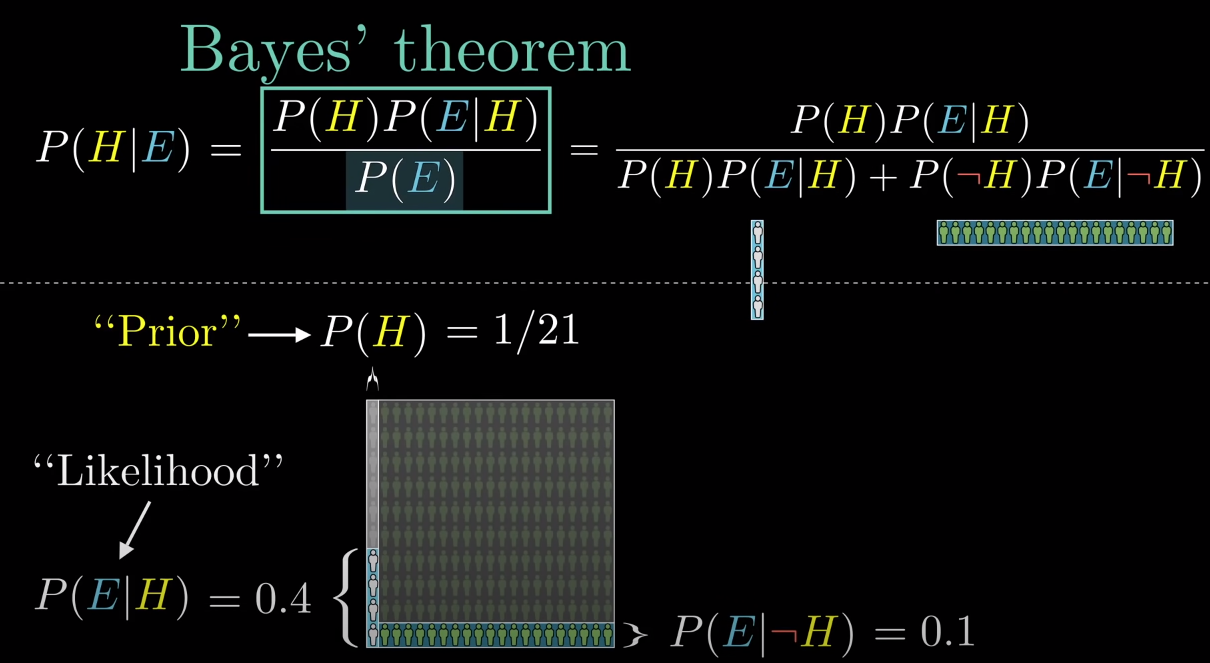
Naive Bayes (Multinomial Naive Bayes)#
Spam example:
Start with prior probability of a message being normal or spam (e.g. use proportion of messages that are spam).
Multiply by the probabilities of each word being in a normal or spam message.
Resulting probabilities are proportional to the probability of being normal or spam; so take the highest probability.
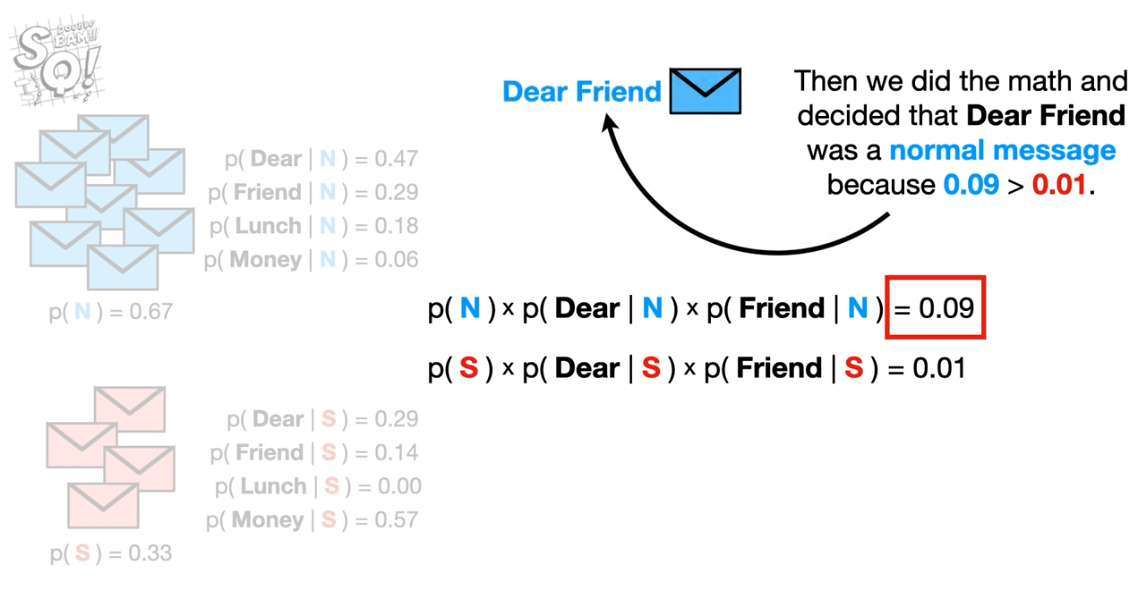 But, in the above example ‘lunch’ is given 0 probability in spam as it has not been observed. This would mean that the resulting spam probability for a message with ‘lunch’ in it will always be zero, no matter the make-up of other words. To get around this people usually add a constant (\(\alpha\)) to all measured word frequencies in both normal and spam messages.
But, in the above example ‘lunch’ is given 0 probability in spam as it has not been observed. This would mean that the resulting spam probability for a message with ‘lunch’ in it will always be zero, no matter the make-up of other words. To get around this people usually add a constant (\(\alpha\)) to all measured word frequencies in both normal and spam messages.
Naive Bayes is naive because it ignores word orders (it uses ‘bag of words’).
Gaussian Naive Bayes Classifier#
Data is summarised in Gaussian distributions for each feature. Given a new case, we use the distributions to calculate likelihood for each feature value occurring for each class, and apply the naive Bayes method as above.
Using natural log values (and adding these logs) for the calculation avoids underflow calculation errors, where values are too low for CPU to calculate properly.
